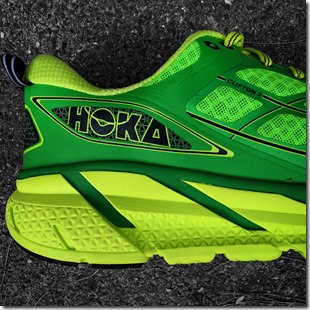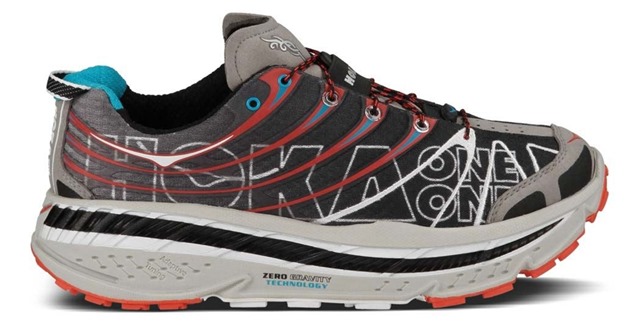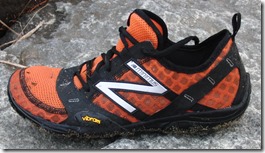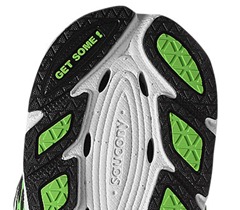 One of the drawbacks of the scientific research process is that it is slow. It takes time to run experiments, write up results, and get those results published in a peer-reviewed journal. As a result, popular trends tend to take off before science has a chance to validate the beliefs that sparked those trends.
One of the drawbacks of the scientific research process is that it is slow. It takes time to run experiments, write up results, and get those results published in a peer-reviewed journal. As a result, popular trends tend to take off before science has a chance to validate the beliefs that sparked those trends.
We saw this process play out with the minimalist running trend – it took off like a rocket, but the reality is that though science has shown that people do typically run differently in minimal shoes, they are not the same as running barefoot, and injury rates among those transitioning into minimal shoes aren’t any different than those who continue to use a traditionally cushioned running shoe (though the types/location of injuries likely differ).
Over the past few years the hot trend in running has been maximal cushioning. Shoes like those made by the brand Hoka One One have been very popular, and sales are booming. However, to date there has been very little scrutiny of these shoes by the scientific community. That doesn’t mean that scientists are ignoring them, it just means that any data that has been collected has yet to be published (again, science is slower than trends).
Yesterday a friend (thanks Marc!) sent me the abstract of one of the first studies I have seen to look at how maximalist shoes affect running form. The abstract is of a presentation from the annual meeting of the American College of Sports Medicine. The lead author is Matthew Ruder from the Spaulding National Running Center at Harvard Medical School, and the title of the study is “Effect of Highly Cushioned Shoes on Ground Reaction Forces during Running.”
The study included five runners who ran in both highly cushioned and traditional running shoes. The abstract does not report what the highly cushioned shoe was, but Craig Payne indicates that it was the Hoka Stinson (see image below) in a thread on Podiatry Arena. They found that vertical impact peak, instantaneous vertical impact loading rate, peak medial force, and peak vertical force did not differ between the two shoes. Average vertical loading rate (VALR) was greater in the highly cushioned shoes, and peak lateral force was lower in the highly cushioned shoes. Regarding the latter, the authors suggest it could reduce the pronatory moment on the foot (i.e., less force forcing the foot into pronation, maybe due to the soft cushioning). They also note that higher VALR has been linked to injury (e.g., tibial stress fracture).
Now, these results need to be interpreted with caution – this was a conference presentation and not a published paper, and the sample size of five runners is tiny (they indicate that they plan to increase the sample). The results are also highly dependent on which shoes were chosen for the experiment – I don’t know what the traditional shoe was, and some of them have quite a bit of soft cushion under the heel. However, it is interesting, and somewhat surprising, to find that a big, cushy shoe like the Hoka Stinson (assuming that it is correct that the Stinson was the shoe they used) yielded a higher impact loading rate than a traditional running shoe, and that most other variables did not differ.
One thing I disagree strongly with is the opening sentence of an article on Medscape that discusses the study (you need to create a free membership to read it). It reads: “Highly padded maximalist shoes could increase the risk of running injury, researchers say.” This is a great example of bad journalism – the study did not look at injuries at all, it looked at forces. Furthermore, there remains considerable debate about whether impact forces are a major factor in causing running injuries. For example, running with a forefoot strike in minimal shoe can reduce vertical impact loading rates, but research has not found that running in minimal shoes reduces injury rates relative to traditional shoes. And peak vertical force, which I presume is the force at roughly midstance (the active peak), did not differ between the shoes. Some would say that the latter is far more likely to contribute to injury risk since forces are typically much higher during the active peak.
So does this mean it’s time to ditch your maximalist shoes? No, just as there is as yet no compelling data that running in minimal shoes is more dangerous than running in a traditional shoe, we don’t yet have any evidence that maximal shoes actually increase your risk of injury. And my guess is that there may be things going on above the foot in maximal shoes – for example, I suspect less knee flexion in a shoe like a Hoka due to the soft, thick, cushy sole. This could have benefits for the knee. So for now, I continue to say that different shoes will alter how forces are applied to the body, and it remains a matter of finding the best match for you as an individual.




















Great insight Pete. I need to read up more about shoes and VALR. I continue to suffer from tibial injuries, recently having to take a forced layoff after racing a half-marathon in Hoka Cliftons. This article may be on to something..
Although I’m a minimalist runner, I wore Hoka One One Challenger ATR to run a 80 km trail race end of March (this was for a review). The result : sever knee pain (both knees) since. Medicine is unable to find the cause …
Fredbros,
It has been my experience that changing anything running related too quick is a bad idea. The old too much, too soon, has bitten my butt more than I care to say! :) The treadmill study Pete quoted in his book (I think), showed there is an optimal amount of cushion (like 10mm) that most people (in the test sample) did the best with. The problem is we are all different, and we all have to find what works the best for how we are made. The first key is don’t do too much too soon or change too many things at once. The second is don’t mess around with what works, because if you are injury free, you must be on to something good for sure! Now if I could just follow that advise myself, that would be something! Hope your knees get better soon. I’ve found in my 30+ years of running, time off of running is the best medicine when nothing else works. This allows your body to hit the reset button. Hang in there Bro! Steve
Pete – small correction; the abstract for the presentation did say 5 subjects and included the data on the five; due to the timelines of submitting abstracts for conferences, the final presentation did include 14 subjects – the Medscape article had the data from the 14 (more were recruited after abstract submitted) … though the results stay the same.
I too take exception to the opening statement in the Medscape article: “Highly padded maximalist shoes could increase the risk of running injury, contrary to manufacturers’ claims, researchers say.”
What manufacturers are claiming that?
Thanks for the info Craig! Any chance you know the model of the traditional shoe?
They are Nike Air Pegasus.
Nike Air Pegasus was the ‘traditional shoe’!
…which means they compared a cushioned running shoe to a cushioned running shoe and the cushioned running shoe did not reduce impacts forces compared to a cushioned running shoe … go figure!
I am curious when they setup these studies do they identify the shoes by popular models or do they classify them by performance. I would think that to compare a heavily cushioned maximalist shoe versus a traditional runner, you might look at compression set, peakg (shock attenuation) and actual thickness?
https://www.youtube.com/watch?v=2HHylr2Kitg
I think you could conclude Hoka links their product to lesser injuries after watching this official video.
I see nothing in that video where the manufacturer claims that you get less injuries from using their shoes. I see a couple of runners say that they helped their injury – nothing wrong with that.
Indeed there are many injury related claims in the video, but Hoka was smart to make they subtle enough (so that they don’t make Vibram’s mistake).
Thanks for the link.
Well, well, well. I knew it was only a matter of time before we saw things like this. I enjoyed another injury-free nine miles in my old, uncool Altra Samsons today. Been enjoying my Nike Zoom Streak LT 2s too.
To say that no one says that Hokas prevent injury is just nonsense. I guess Hoka has been more careful, so that they don’t run into the same problem Vibram did. But come on, when they first came out, the big appeal was that these shoes helped people with injuries run again, and they allowed ultra runners to run long distances and still feel fresh. That’s the kind of stuff you heard all the time. When I see people wearing them in 5ks, I often ask about them (acting like I don’t know anything about the shoe) and the people ALWAYS say stuff about how they’ve helped with pain in their knee or foot or some other injury. Why else would all that cushioning be there, if not to protect from injury?
Individuals with injuries are being helped by Hoka’s and Vibrams – but Hoka One One certainly are not claiming that they prevent injury as is alleged by the researchers in the Medscape article on the study.
They are not, but clearly the purpose of such a shoe is to prevent injuries more than a shoe without such a generous stack height. The fact remains that switching shoes alone will not prevent injuries. A shitty runner will screw themselves up in any shoe. Switching to Hokas my lead runners to believe that they have found the answer to their problems. With this study, we are now seeing that no shoe is a magic cure. I look forward to more scientific evidence in the future.
I want to mention that I am not interested in a minimal vs. maximal or barefoot vs. shoes debate. I think being in one camp or another is ridiculous. I like being able to run day after day in minimal shoes and not get hurt, and I’m kind of a show-off about it, which is annoying. But I’m a RUNNING FORM evangelist. I believe that is “The Way.” I happen to think that it is easier to figure out what good form is when barefoot or in minimal shoes, however.
Great point(s) Michael, and they make lots of sense. Would you be able to share your experience with shoes, injuries and running form PRIOR to going minimalist?
Reply to Fran:
Prior to working on my FORM, I sucked. I always wore some bulky ASICS trainer. I was slow, my right knee usually started hurting after a while, and running 2-3 miles seemed really far. I never entered races and just assumed I was hopeless and that marathons were for special people. Experimentation and research helped me figure out how to become more skilled and avoid injuries.
As an older runner, I’ve been much healthier the last year and a half in a couple models of Hokas than I was the prior 2 years in light trainers such as Nike Free 3.0, Kinvara, and PureFlow. My son does great in Kinvaras and I liked them too, I’m just able to run more consistently in Bondis or Cliftons. As for form, I feel like I was too hyper aware of my feet in thinner shoes and unable to detect flaws in upper body posture. Since I’ve been in the Hokas, I feel like I’ve gradually been able to figure out some upper body issues because I’m not so conscious of the feet. The comment in the study about reduced lateral forces may be a big reason why they’ve helped my predominantly lower leg muscle issues. Some comments I read along the lines of “just fix your form” sound like telling a golfer to “just fix your swing.” Easier said than done.
Great post! Thanks for sharing this nice information with us.
I just wonder if the rocker plus the high stack height either help people with their personal gait problems, and hurt other people? I can feel the difference when and where my foot hits the ground when I change between a higher and lower stack height and difference between low and high drop. I feel like I’m “early”, with too much stack+ too much drop (10mm+)-like I’m jamming my knee. Late with too low stack, and too low drop (4mm-)-like I’m a little out of balance, and landing too much on fore foot. My sweet spot is 16mm front, and 22-24 back:6mm-8mm drop. And I do best with cushion on the softer side, esp. in heel. I think stack height amplifies differences. Has anybody noticed this? P.S. The golf swing is similar: Stance, balance, swing within yourself (not over reaching with your lead leg), speed of swing=cadence-which everyone has their own internal speed which varies slightly.
I enjoy my minimalist shoes but I have to say the Hoka Stinsons or Challengers are great on trails strewn with pebbles, rocks and roots that are hidden under dead leaves etc….Bad form will still result in sore achilles or whatever but the cushioning really helps me get through long trail runs without bruising my feet.
Looking forward to seeing more info come out on this subject. The comments are just as interesting!
Great post, Pete. I appreciate your willingness to share this interesting info while still recognizing the shortcomings of the current state of research.
And Craig–couldn’t agree more with your Pegasus comments, might not have been the best control shoe.
Hey Pete late to the party on this one!
Did you see this recent controversy over the eating chocolate study? That whole episode made me think about how shoe science is presented in the media as well…and I agree with you that much more caution is needed in interpretation. To be honest I feel that researchers are caught in a trap in that most grant money probably comes from a particular brand who might desire certain outcomes (remember vibram had several of the less than 10 sample size studies touting its wears). The irony is that if the researcher goes it alone they are likely to be limited by small sample size as well.
Science works but it has to be done properly, that is studies must have enough participants to control for age, weight, gender, years running etc. In addition it must have clear enough boundaries in defining various shoe groups participating. This kind of study would likely require thousands of runners and quite a bit of money to undertake. Perhaps someone could design some self-reporting study with a social media app that tracks data and relies on participant reporting, obviously that would not be scientific but at least it could overcome the perpetual sample size issue. Otherwise it seems to me runners today are left with personal anecdote based off lots of choices. That’s why we need those shoe reviews! No runner can possibly even hope to try a tenth of the shoes available.
Kev – I agree, it is tough. Sample sizes need to be big enough to get meaningful results, and that requires money. Unfortunately a lot of the money for shoe studies likely comes from the industry, which always makes you worry about bias. And don’t even get me started on the media part of the problem! I’ll keep doing what I can to put out good info :)
These studies should always be taken with a grain of salt. As Pete has said, endlessly, the interaction between a shoe and it’s wearer is as individual as our finger print.
However, I will say this: Measuring impact force is interesting, but can be deeply misleading. 160 pounds forced on 5 square inches of platform is the same, regardless of the shape of the platform. How that force is distributed around that platform could have absolutely nothing to do with the stack height. The lacing, cushion, density, shape of the upper, heel counter, etc. etc. etc. are all working to make things happen, and an impact study can’t give much insight into that. Now add physiology, form, etc. etc. etc. and you’re back to Pete’s ultimate advice: Feels good? keep going. Start hurting? Try something else.
Hi Pete, sorry for my late answer.
My opinion on “I suspect less knee flexion in a shoe like a Hoka due to the soft, thick, cushy sole. This could have benefits for the knee.”
I think bigger shoes will (for most cases… according of the kinematic, kinetics and muscle contraction timing that are associate with this type of shoe)
– decrease knee flexion position at the landing (more extended knee)
– increase range of motion of flexion during the contact phase (more excursion)
– decrease pre-contration of muscle around the knee and leg (tension of the muscle-tendon unit to absorb the landing… that bring )
– increase compression force of the PF (according to timing of contraction and associated kinematics)
– increase anterior shirring stress of the tibia and tension of the ITB
– increase (?) compression force of the TiFe (according to the kinematic)
So I will say that I’m absolutely not convince that bigger shoe will help knee problems/pathologies… to the opposite of helping/protecting the foot.
All best
blaise
Hi, Pete,
Sorry, I’m pretty late with my commentary. Good blog post. Thought I’d provide an update and stir the softer midsole / highly cushioned shoe pot!
Despite small sample size in the Nat’l ACSM study, the question regarding soft midsoles vs. stiffer ones is slowly being answered. See: Jennifer Baltich*, Christian Maurer, Benno M. Nigg. (2015). Increased Vertical Impact Forces and Altered Running Mechanics with Softer Midsole Shoes. PLOS ONE, DOI:10.1371/journal.pone.0125196) – Human Performance Laboratory (HPL), Faculty of Kinesiology, University of Calgary, Calgary, Alberta,
* jbaltich@ucalgary.ca (contact person)
In brief, they had a large sample size and found significantly higher vertical impact forces with softer midsole shoes (I’m guessing Hoka would claim they have the “softest” midsoles; on their website they say: “excellent shock absorption and an inherently stable ride”). Not sure they can say “excellent” shock absorption when highly cushioned shoes transmit greater vertical impact forces and create greater ankle and knee stiffness = recipe for cumulative overloading and possible injury.
Although injury rates were not tracked, it’s prudent to at least speculate injury rate “could” be greater in softer midsole shoes from what the evidence is starting to say.
A final case in point is a case study: 44 yr old male runner; 34 yrs of hard training and competition interspersed with cross training and consistent strength training with legs and upper body; never a knee problem; started wearing Hoka Stinsons 3-4 x week for 4-months; ended up with a completely torn posterior medial meniscus root (only 10% of meniscus injuries are root tears and usually root tears occur in people older than 50 yrs, who are obese and sedentary); surgery revealed normal knees with no degeneration of articular cartilages, ACL, etc; at least 51% of the smoking gun is the use of Hokas over time with increased vertical forces/loading and knee stiffness; and, physics will tell you because of the greater distance from the subtalar joint at ground contact point = increased torque about the ankle and thus knee; lengthening the moment arm = increased torque despite body weight impact force remaining the same; to confirm, Hokas increase your distance from the the ground reaction force = greater torque about the subtalar jt and knee = simple physics). Hokas: good for the road and flat, non-technical trails; otherwise, I’d caution their use.
Stay tuned…Vibram = lawsuit and debunked; Sketchers Shape Ups = found to be false claims and upheld despite Sketchers’ suing Dr. John Porcari, a well known Exercise Physiology researcher from UW-LaCrosse. If it’s too good to be true…it is. As always, no one shoe or gimmick fits all…despite what the company wants you to think…
Thanks for the comments Scott, interesting stuff. I’ll need to dig up that Nigg paper for a future post.
I think it’s interesting to note that the minimalist/barefoot movement didn’t significantly affect the elite runners whereas many of them ARE incorporating “maximalist” shoes into their rotation.